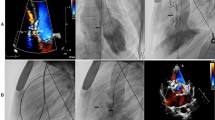Abstract
This retrospective, single-center study evaluated short-term and mid-term results of minimally invasive surgery to occlude ventricular septal defects (VSDs) using a subaxillary approach. The procedure was performed on 429 children (224 boys, 205 girls; age 2.4 ± 2.5 years; mean weight 12.7 ± 10.1 kg) between January 2014 and December 2016 at the Children’s Heart Center of Henan Province People’s Hospital. An approximately 2-cm subaxillary incision was made between the third and fifth ribs, and the appropriate right atrium or ventricle was punctured under the guidance of transencephalographic echocardiography (TEE). The VSD was then occluded under TEE guidance. The mean size of the VSDs was 4.2 ± 1.0 mm, and the occluder measured 5.3 ± 1.3 mm. Asymmetrical occluders were used in 44 patients and symmetrical occluders in 385 patients. The operative time was 60.7 ± 21.3 min, and time in the intensive care unit was 20.9 ± 6.5 h. Blood loss was 12.4 ± 14.4 ml. There were no deaths among these patients. Occluder displacement occurred in two cases. There were no complications (e.g., third-degree atrioventricular block, new aortic regurgitation, reoperation for massive bleeding, serious infection). All patients were followed for 6–48 months, during which time there were ten cases of a postoperative residual shunt, which self-closed in eight during follow-up. The other two cases are still being followed. No complications occurred during follow-up (e.g., reoperation, aortic regurgitation, atrioventricular block, occluder abscission). Occluding VSDs using the subaxillary approach is safe and effective. Short-term and mid-term results are satisfactory. Further follow-up is required regarding long-term results.


Similar content being viewed by others
References
Penny DJ, Vick GW 3rd (2011) Ventricular septal defect. Lancet 377:1103–1112
McDaniel NL (2001) Ventricular and atrial septal defects. Pediatr Rev 22:265–270
Xing Q, Pan S, An Q et al (2010) Minimally invasive perventricular device closure of perimembranous ventricular septal defect without cardiopulmonary bypass: multicenter experience and mid-term follow-up. J Thorac Cardiovasc Surg 139(6):1409–1415
Hongxin L, Zhang N, Wenbin G et al (2014) Peratrial device closure of perimembranous ventricular septal defects through a right parasternal approach. Ann Thorac Surg 98(2):668–674
Hazekamp MG et al (2010) Surgery for transposition of the great arteries, ventricular septal defect and lef ventricular outfowtractobstruction: European Congenital Heart Surgeons Association multicentre study. Eur J Cardiothorac Surg 38:699–706
Tao K, Zhu D, An Q et al (2012) Perventricular device closure of patent ductus arteriosus: a secondary chance. Ann Thorac Surg 93:1007–1009
Zhang GC, Chen Q, Cao H et al (2013) Minimally invasive perventricular device closure of ventricular septal defect in infants under transthoracicechocardiograhic guidance: feasibility and comparison with transesophageal echocardiography. Cardiovasc Ultrasound 11:8
Hu S, Yang Y, Wu Q et al (2014) Results of two different approaches to closure of subaortic ventricular septal defects in children. Eur J Cardiothorac Surg 46:648–653
Yin S, Zhu D, Lin K et al (2014) Perventricular device closure of congenital ventricular septal defects. J Card Surg 29:390–400
Ou-Yang WB, Li SJ, Wang SZ et al (2015) Echocardiographic guided closure of perimembranous ventricular septal defects. Ann Thorac Surg 100:1398–1402
Xing Q, Wu Q, Shi L et al (2015) Minimally invasive transthoracic device closure of isolated ventricular septal defects without cardiopulmonary bypass: long-term follow-up results. J Thorac Cardiovasc Surg 149:257–264
Sun JJ, Fan TB, Peng BT et al (2015) Effect of surgical treatment of congenital heart disease by right subaxillary small incision surgery. Chin J Pract Med 42(5):20–21
Song SB, Fan T, Li B et al (2016) Minimally invasive closure via subaxillary approach for common congenital heart disease: a mid-term follow-up study. Chin J Thorac Cardiovasc Surg 32(11):680–682
Liang WJ, Fan TB, Li B et al (2015) Surgical closure of perimembranous ventricular septal defect through small incision via right subaxillary approach. Chin J Chin J Appl Clin Pediatr 30(13):1037–1038
Wang S, Zhuang Z, Zhang H et al (2014) Perventricular closure of perimembranous ventricular septal defects using the concentric occluder device. Pediatr Cardiol 35(4):580–586
Luo YK, Chen WH, Xiong C et al (2015) Comparison of effectiveness and cost between perventricular device occlusion and minimally invasive surgical repair for perimembranous ventricular septal defect. Pediatr Cardiol 36(2):308–313
Zhou SJ, Fan TB, Song SB et al (2017) Follow-up results of minimally invasive closure of subarterial ventricular septal defect through left subaxillary approach. Chin J Appl Clin Pediatr 32(13):993–995
Hu SS, Pan XB, Chang Q (2017) Expert consensus on interventional diagnosis and treatment of common cardiovascular diseases through surgical approaches. Chin Circ J 32(2):105–119
Acknowledgements
We gratefully acknowledge the roles of all our colleagues, nurses, and others involved in the care of the study patients. We thank Nancy Schatken BS, MT(ASCP), from Liwen Bianji, Edanz Group China (http://www.liwenbianji.cn/ac), for editing the English text of a draft of this manuscript.
Author information
Authors and Affiliations
Corresponding author
Ethics declarations
Conflict of interest
All authors declare that they have no conflicts of interest.
Ethical Approval
The study was approved by the Medical Ethics Committee of the Henan Provinces of People´s Hospital. All procedures performed in the study involving human participants were in accordance with the ethical standards of the Institutional Medical Ethics Committee and with the 1964 Helsinki declaration and its later amendments.
Informed Consent
Informed consent was obtained from the parents of all individual participants included in the study.
Rights and permissions
About this article
Cite this article
Hu, X., Peng, B., Zhang, Y. et al. Short-Term and Mid-Term Results of Minimally Invasive Occlusion of Ventricular Septal Defects via a Subaxillary Approach in a Single Center. Pediatr Cardiol 40, 198–203 (2019). https://doi.org/10.1007/s00246-018-1980-y
Received:
Accepted:
Published:
Issue Date:
DOI: https://doi.org/10.1007/s00246-018-1980-y




